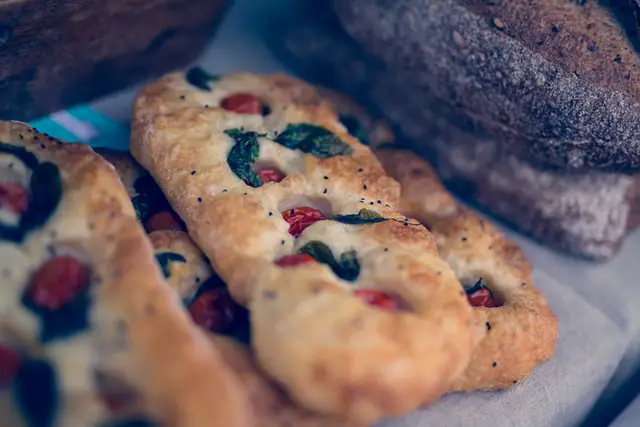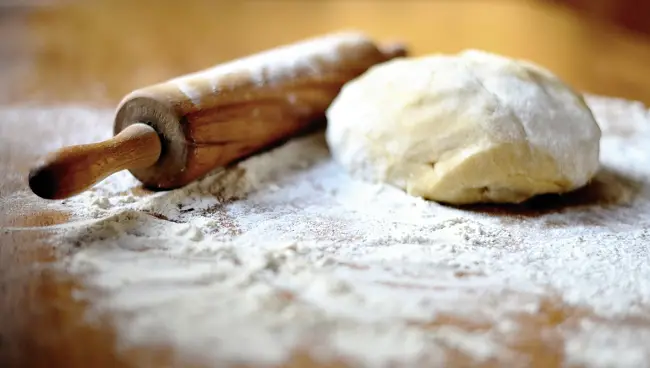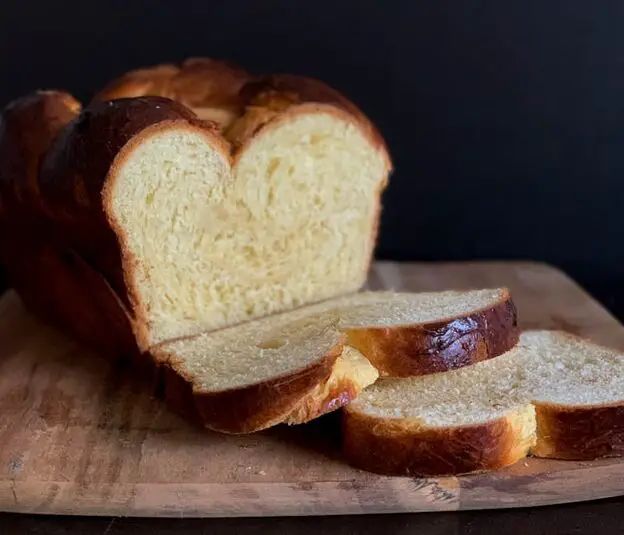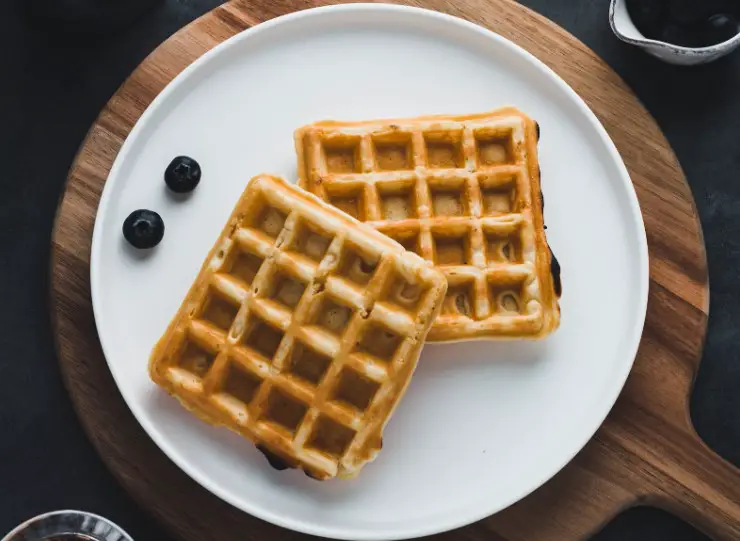Focaccia bread is one of my favourite bread to bake. When I first started baking focaccia, I always had this problem where after baking, it just sticks to the pan even though I have oiled it.
The most common cause for this is that the pan wasn’t greased with enough oil. Just lightly brushing the pan isn’t enough. Because you are using the same pan to do the final proofing for the dough, you want to make sure there is enough oil to coat when the dough doubles in size.
Other Reasons Why Your Focaccia Is Sticking To The Pan
- Undercooking Your Focaccia. Another reason might be that the focaccia is undercooked at the bottom. Sometimes, the heating element in an oven might not be even. So you might see that the top part of the bread is crispy brown, but the bottom might be undercooked. And the focaccia dough is sticky to begin with. So if it isn’t cooked through, and you try to remove it from the pan, you are going to have them sticking to the pan.
- The material of the pan that you are using. If you are using an pan that has a rougher finish on the surface, this might cause the bottom to stick more, compared to using a pan with a more polished, smoother surface.
How to prevent focaccia from sticking to the pan
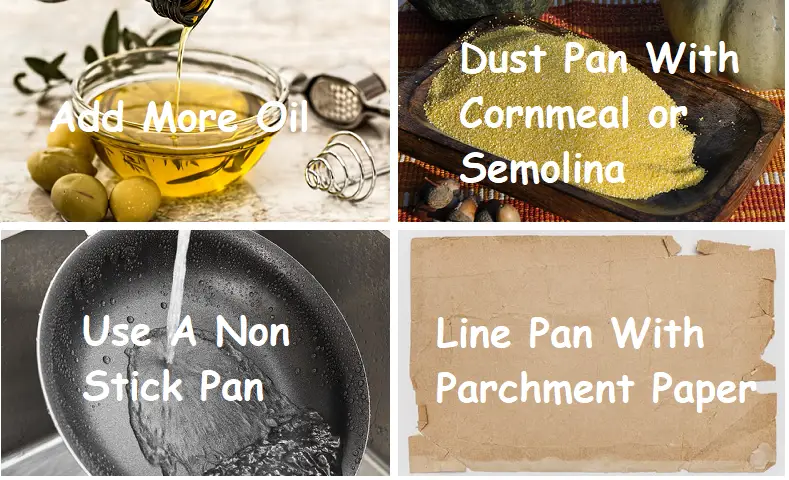
Add more oil
The most obvious solution is to add more oil. I usually put in an amount that looks like I’m semi frying or pan frying the dough. It might look like a lot of oil to begin with, but once your dough double in size, it will just be the right amount.
You also want to be meticulous when you are spreading the oil. Pour a generous amount of oil and rotate your pan. Make sure to cover all the areas in the pan. If you miss one spot, that’s where it’s going to stick.
Dust the pan with cornmeal or semolina
Adding cornmeal or semolina to the bottom of the pan is a good alternative to adding more oil, if you want a healthier version of focaccia bread. Before putting your dough in the pan for the final proof, dust the pan with some cornmeal or semolina (not semolina flour).
I would still recommend adding a little bit of oil to the bottom together with the cornmeal or semolina, simply because fried bread taste better!
Line Your Pan with parchment paper/Baking Paper
Lining your pan with a parchment paper is also another way to prevent focaccia from sticking to your pan. If you are using pans with a rough surface, you can consider this option to prevent it from sticking.
To do this, first brush your pan with oil, then put the parchment paper on it. Make sure that the parchment paper covers all areas that the dough is going to be. Then add another layer of oil on the paper. You will want some oil on the parchment paper to help crisp up the bottom.
This article first appeared on savemybakes.com.
Use a non stick pan
If you have a non stick pan, you can consider using it for baking your focaccia. This way, you definitely won’t have the problem of focaccia sticking to your pan.
The only point to note, when using a non stick pan is to make sure that you do not overheat your pan. The non stick coating can melt under high heat.
Ensure the bottom is cooked through
Focaccia dough is a very wet dough. If it is not cooked through, and you try to remove it from the pan, you will have some part of the bread sticking to the pan.
To ensure that the bottom is cooked through properly, after you see that the top part of the focaccia is brown, you can lift the edges of the bread to check if the bottom part is brown as well. If not, just let it bake for a couple more mins.
What I like to do is, to move the pan to the bottom rack for the last 5 mins. This will allow the bottom of the focaccia to crisp up.
How do you remove focaccia from a pan
When the focaccia comes out of the oven, it is best to remove it from the pan within 5 mins. This will ensure that the focaccia bottom remains crispy.
Of course if you had greased it well, it should just slide right off the pan without any effort.
However, the bottom of the focaccia will stick to the pan if you didn’t grease it well. if this happens, try using a butter knife or a spatula to run it around sides of the bread to loosen the side. Then I like to use a fork, and make tiny stabs between the bottom of the bread and the pan to loosen the bread more. At this stage, try shaking the pan to see if it slide off.
If it still doesn’t come out in one piece, you can try slicing the area where the bread is not sticking to the pan and serve that.
And if all else fails, eat from the pan. It will still taste as good.
How To Easily Wash Your Focaccia Pan after Baking
I don’t recommend scrubbing your pan with a steel wool or the scrubby side of your sponge. This will create scratches and mar the finish on your pan which can cause the bottom of your focaccia to stick even more.
If you don’t have any focaccia sticking to the pan, just wipe off the layer of oil with a paper towel first. Then wash it off with water.
However if you have bits of bread sticking to the pan, then soak the pan with water for an hour before washing. This will make it easier to remove the bread that are sticking to the pan. After that, just wipe off those bits, and it should come off easily.
Can I Bake Focaccia in a Glass Pan?
Firstly, I can tell you that baking focaccia in a glass pan is possible. I’ve personally tried baking bread in glass and found the results satisfactory.
However, when I baked in a glass pan without using parchment paper, I faced some challenges. Despite lathering my pan with generous amounts of oil, the focaccia clung stubbornly, making it a hassle to remove. Sometimes, it was a breeze, but on other occasions, it felt like the bread had become one with the glass.
From a technical standpoint, I’ve learned something valuable about heat conduction. Glass tends to insulate more, which might impact that oven spring we bread bakers adore. Metal pans, on the other hand, conduct heat better and could lead to a crustier and more lifted bread. That said, some of my baking pals, swear by their glass pans and have baked tasty focaccias in them. One even preferred the crispy crust from a glass pie dish over a baking sheet version.
Yet, if I were aiming for that perfectly thin, caramelized crust, I’d probably lean towards using a baking sheet. Glass pans might not be the optimal choice for that classic focaccia texture, but they don’t fall too far behind.
So, in my experience and from what I’ve gathered, you can definitely bake focaccia in a glass pan. But if it’s that classic, crusty bottom you’re after, I’d recommend a metal baking sheet. Either way, it’s all about the journey and the joy of baking!

